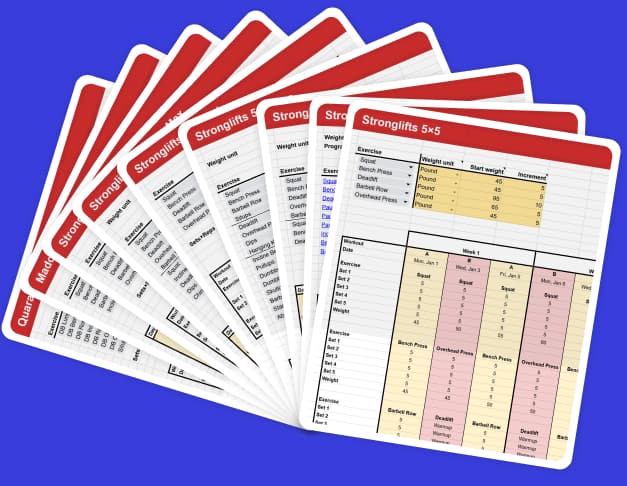Failing reps on Stronglifts 5×5 is normal.
The strongest lifters have all experienced failure at some point. Failing reps is an opportunity to improve how you approach your workouts. You can reflect on your training and make adjustments. This helps you progress again.
Failing reps also means you’re moving beyond the easy beginner gains. You’re becoming more advanced. The same 5lb increment that used to be easy now requires more effort and attention to details. You’re challenging yourself more to add weight. This is key for building muscle and strength.
In this guide, I’ll show you the different types of failures on Stronglifts 5×5, why they happen, and what to do if you fail reps.
Contents
- Types of failures on Stronglifts 5×5
- Top reasons for failing reps on Stronglifts 5×5
- What to do if you fail reps on Stronglifts 5×5
- Frequently Asked Questions
- What if you fail on Bench Press but not on Squat?
- Shouldn’t you keep the weight of each exercise in line with others?
- What if you repeat the weight but still fail next workout?
- What if you repeat the weight three times but still fail?
- Why not deload after one failed workout already?
- Wouldn’t it be better to microload before failing reps?
- What if your gym doesn’t have small plates for microloading?
- What if you’ve tried everything and are still stuck?
- References
Join the Stronglifts community to get free access to all the spreadsheets for every Stronglifts program. You’ll also get 15% off Stronglifts Pro, and daily email tips. Enter your email below to sign up today for free.
Types of failures on Stronglifts 5×5
Failure to lift the weight
This is the main type of failure on Stronglifts 5×5.
You attempt to lift the weight for five reps. But you can’t do more than one, two, three or four reps. The weight just won’t go up when you try. It’s a failed set because you didn’t complete five reps.
Examples…
- Squat: you do four reps. You go down for the last rep. But you can’t Squat it back up. You get stuck halfway. The weight goes back to the horizontal safety pins of the Power Rack.
- Bench Press: you do three reps. You lower the bar for rep four. But you can’t press it back up. It goes back to your chest. Your spotter has to help you lift the weight back into the uprights.
- Deadlift: you do two reps. You try to pull the third rep off the floor. But the bar barely moves. It stays stuck on the ground.
- Overhead Press: you do four reps. You try to lift the last rep but the bar won’t move past your chin. It goes back to your shoulders.
- Barbell Row: you try to pull the last rep off the floor. You can’t get it past your knees. It returns to the floor.
Failure to lift the weights happens when the weight is too heavy. This can be caused by progressing too fast, rushing the sets, poor nutrition, etc.
Premature failure
Premature failure is common on Stronglifts 5×5 but can easily be avoided. It happens when you stop the set before trying to lift the weight for five reps. The set counts as failed because you didn’t complete five reps.
Example: you Bench Press four reps. You have one last rep to do. But you don’t think you can lift it. You have no spotter, no power rack and don’t want to risk getting trapped under the bar. So you stop at rep four.
The issue is that you maybe could have done five reps if you felt safe and tried. Repeatedly doing less reps than you can results in undertraining. This can hinder your progress in building strength and muscle.
Premature failure usually happens due to fear of getting hurt. This can be caused by a lack of spotters, lack of confidence, poor form, etc.
Range of motion failure
Range of motion failure is a common mistake on Stronglifts 5×5. Here, you did lift the weight for five reps. However, you failed to use a complete range of motion on every rep. Partial reps don’t count, and so it’s a failed set.
Example: you Squat three reps. You have two more to do but it’s hard. You really want to get five reps and so you start Squatting less deep. This makes the weight easier to lift by shortening the range of motion.
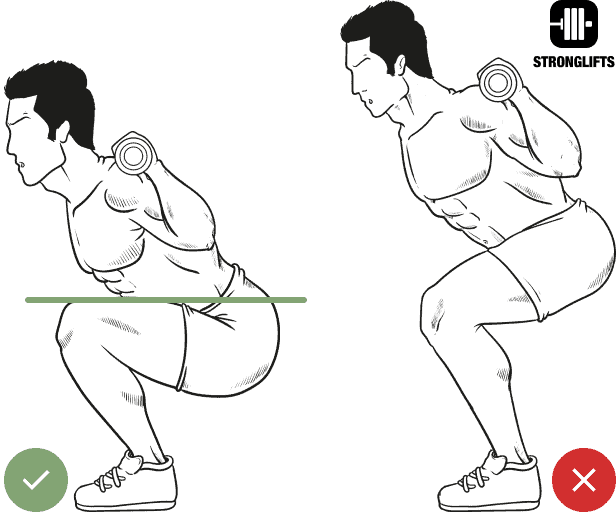
Proper Squat form is going down until your hips are below your knees (1). If you draw a horizontal line from the top of your knees, your hips should be right below that line at the bottom of your Squat. Partial Squats where you only go half the way down allow you to lift more weight. But they build smaller leg muscles (2). Partial Squats therefore count as failed reps.
On the Bench Press, range of motion failure is not lowering the bar all the way to your chest or lifting your butt off the bench. On the Overhead Press, the temptation is to involve the legs instead of keeping them straight.
Range of motion failure is a form of cheating. The weight is too heavy to lift with a complete range of motion and so a shortcut is used. The problem is that consistently doing partial reps will develop weaknesses. These can only be fixed by reducing the weight so a complete range of motion can be used. Cutting the range of motion short is therefore a dead end.
Range of motion failure is typically caused by progressing too fast, prioritizing adding weight over maintaining proper form, ego lifting, etc.
Equipment failure
Equipment failure is a type of failure where you fail by accident. You try to lift the weight for five reps. But you didn’t set yourself or the equipment properly. This causes you to miss reps and so it’s a failed set.
Example: you set up too high on the bench for Bench Press. The bar now travels too close to the uprights. On rep three, the bar hits the uprights by accident. This throws you off balance. To avoid this on rep four, you adjust your form. You press in a more vertical line. But this makes the weight harder to Bench Press (3, 4). And so you miss the rep.
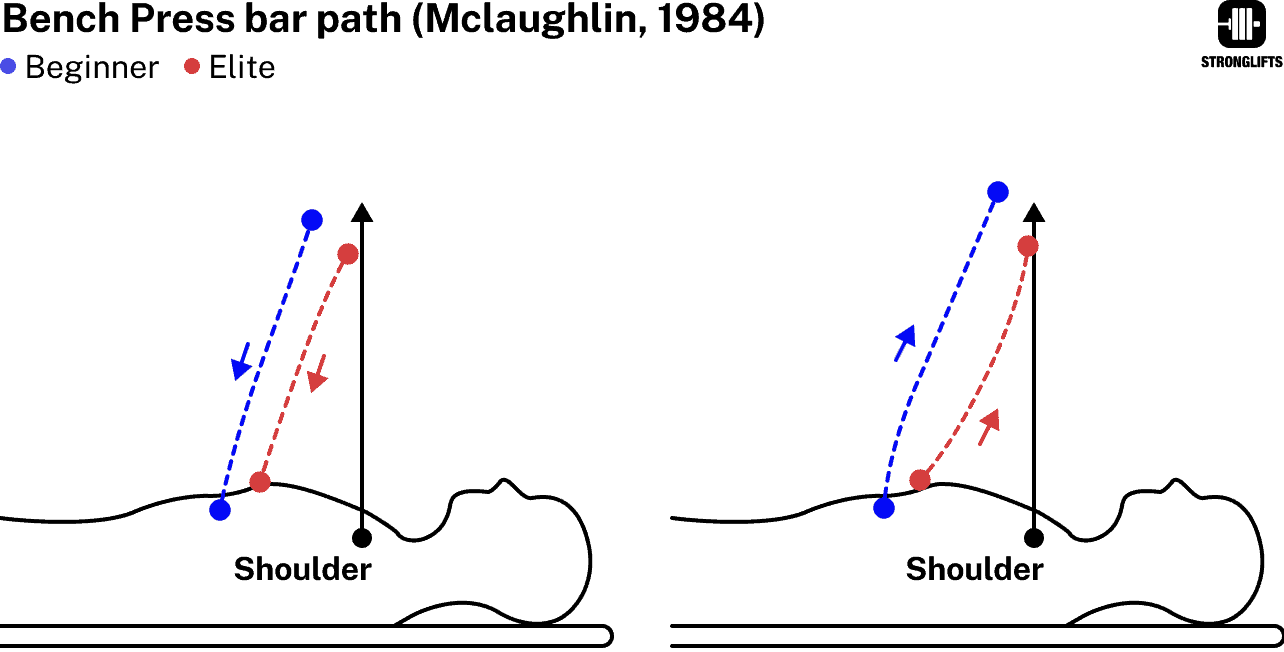
Another example: you Squat in the Power Rack. But the horizontal safety pins are set too high. This isn’t an issue on the first four reps. But on the last rep you go down a little deeper. The bar hits the pins by accident. This throws you off balance. The bar goes back to the pins. You fail the last rep.
Equipment failure can be frustrating because with a proper setup you would likely have completed the set. You can easily prevent this by setting yourself and the equipment properly before starting each set. Equipment failure is usually caused by a lack of focus, rushing sets, inexperience, etc.
Technical failure
Technical failure is another common type of failure on Stronglifts 5×5. Here you try to lift the weight for five reps. But you can’t complete the set because you’re using an ineffective technique or your form is breaking down.
Example: you Deadlift three reps. Your legs and back can do two more reps. But your grip is giving out. The bar is rolling in your hands and opening them up. You can’t keep your hands closed to pull the last two reps. You fail the set because you used the double overhand grip like on your lighter sets. You didn’t switch to the stronger mixed grip for this heavier and harder set.
Another example: you’re doing the Overhead Press. The set is hard, your form is breaking down, you’re leaning too much back. It feels unsafe and you don’t want to hurt your lower back. So you stop at rep four.
Technical failure is usually caused by inexperience, fatigue, rushing sets, etc. It can often be instantly fixed like in the Deadlift example above,
Psychological failure
Psychological failure is common with less experienced lifters. Here fear and anxiety overwhelm you before and/or during your set. You psych yourself out and can’t complete five reps. You may be too afraid to even try.
Example: you unrack the weight for Squats. It feels really heavy on your back today. This makes you doubt your ability to do five reps. You hesitate and start taking 10-15 seconds between reps. Standing that long with the weight on your back increases muscular fatigue. You get more tired. This forces you to stop the set before you even get to five reps.
Psychological failure always happens due to fear. This can be caused by a lack of spotters, a lack of confidence, overthinking it, inexperience, etc.
Top reasons for failing reps on Stronglifts 5×5
Not using spotters
When you Squat or Bench Press without spotter, there’s a risk of getting trapped under the bar if you fail. Fear of getting stuck can cause you to cut challenging sets short to avoid embarrassment or getting hurt.
Studies show that people who Bench Press with spotters attempt and complete more reps than those without spotters (5). The presence of spotters provides a feeling of safety and confidence. It helps you push your limits and achieve better results on the Bench Press.
If you train alone like I have for many years, a Power Rack can give you the same sense of safety. The horizontal safety pins can catch the weight if you fail to lift it. Fear is no longer holding you back and so you can push yourself harder. You can attempt reps that you previously avoided. You complete sets that you weren’t sure you could do but actually can.
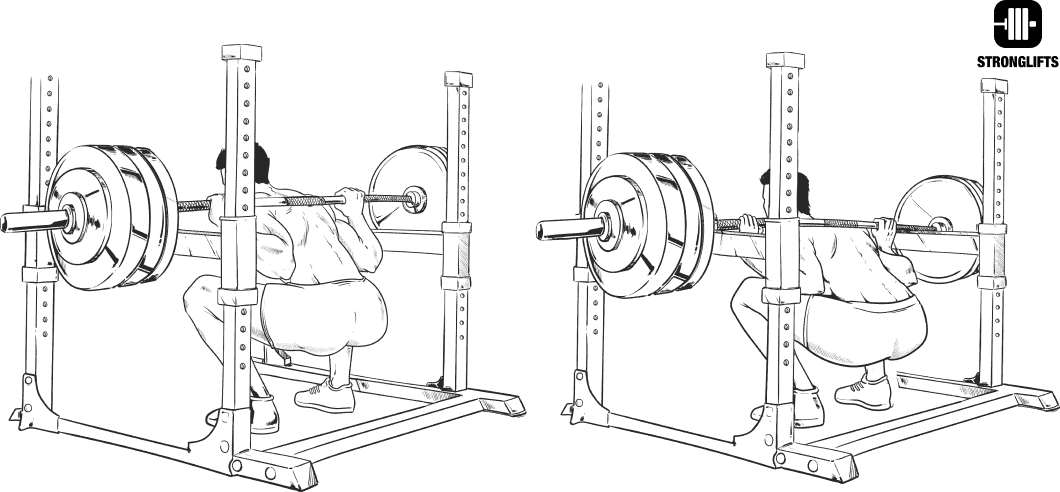
Most people can do more reps than they think they can (6). All those extra reps add up over time. The feeling of safety improves your progress on the Squat and Bench. This results in bigger strength and muscle gains.
Squat and Bench in the Power Rack. Practice failing a few times so you can experience how the safety pins will catch the bar. This will help you overcome fear and anxiety when pushing through hard sets. If you have no Power Rack, ask someone to spot you on your heavy sets.
Progressing too fast
Trying to progress too fast due to impatience usually causes more failure instead of faster results. Avoid these common mistakes…
- Starting too heavy. Some people start Stronglifts 5×5 with a weight close to their 5 rep max. They barely get through five sets. They then wonder why they can’t lift 5lb more in the next workout. It’s because their body had no time to build strength and muscle. The goal isn’t to lift heavy once. The goal is to start light and do more over time.
- Using too big increments. Some people add 10lb per workout because their gym doesn’t have 2.5lb plates. The result is large increases of 60-120lb per month. This is unsustainable, especially on exercises that work smaller muscles like the Bench and Overhead Press. Don’t pick increments based on the available plates in your gym. Pick increments that your body can handle.
- Prioritizing weight over form. Some people cut the range of motion short so they can keep adding weight. Every time they add 5lb on the bar, they Squat half an inch less deep. This isn’t getting stronger. This is moving the bar over a smaller distance. Getting stronger is lifting more weight while keeping a complete range of motion.
- Expecting linear progress. Just because you added 5lb to the bar every workout during the past weeks, doesn’t mean you’ll be able to do this forever. It’s normal for progress to slow down as you get stronger (7, 8). It’s fine to stay at the same weight until you’re ready to lift more. You have to add weight over time to build strength and muscle. But you don’t have to add weight every workout.
Your body will progress at the rate that it can progress. Starting heavier or adding more weight doesn’t mean you’ll progress faster. It usually results in slower progress. Your body doesn’t get enough time to build strength and muscle so it can lift the heavier weights.
Sabotaging recovery
Proper recovery between sets and workouts is important for progress. Poor recovery will cause failed reps. Avoid these common mistakes…
- Rushing sets. During the first weeks of Stronglifts 5×5 you only need 1:30min rest between sets. The weights are light and so the sets are easy to complete. Once the weights are heavier, your ATP-CP energy stores need longer rest periods to recover (9). Resting too little after hard sets decreases how many reps you’ll do on the next set (10, 11). You’ll fail more because your energy stores are depleted.
- Supersets. Alternating sets of Squats with Overhead Press can save time. But you need your legs, lower back and abs to stabilize yourself when you Overhead Press. If those muscles are tired from just doing Squats, it will be harder to stay tight during the Overhead Press. This can cause failed reps. It’s best to do one big lift at a time and with full focus. This also gives you proper rest between sets.
- Poor work capacity. People who were sedentary before they started lifting often lack work capacity. They get tired quickly, recover slowly, and need lots of rest between sets. Squats can leave them exhausted. They can struggle to complete the sets and workout, and fail more reps. Brisk walking for 30 min/day, 5x/week, is a simple but effective way to improve work capacity (read the cardio guide).
- Poor recovery. Some people do 90-120min of hard cardio 4-5x/week. Or they’ll do high volume assistance work to failure on their rest days. They then wonder why they’re tired for lifting. It’s because your body didn’t get proper rest between workouts. Instead of doing easier forms of cardio and assistance work, you do too much and go too hard. This causes more muscle damage and fatigue.
- Poor sleep. The best way to recover is to get enough sleep quality and quantity (12). Your body releases muscle building hormones while you sleep. One week of sleeping less than 5h/night can drop testosterone levels (13). Lack of sleep makes the same workout harder (14). While you can have great workouts after a night of bad sleep, chronic sleep deprivation will hinder your progress. Adults need 7-9 hours of sleep (15). Go to bed on time the night before your workout.
Poor recovery will limit the results of the best training program. Lifting weights stimulates your body to build strength and muscle. But proper recovery is needed to adapt to that stimulus by repairing and building muscles.
Lack of focus
Lack of focus in the gym can result in poor technique, less effort, putting the wrong weight on the bar, etc. This can cause failed reps or even injuries from dropping weights (16). Avoid these common mistakes…
- Multitasking. Minimize distractions like talking too long with people, watching TV or viewing streaming videos between sets. Don’t try to do work while lifting, like reading documents or answering emails. All of this takes your attention away from lifting the weights.
- Smartphones. Reading, writing and posting on social media causes mental fatigue. This can result in less reps done per set (16). Put your phone in airplane mode so you don’t get distracted by social media and messages. Or use a dedicated gym device that only has the Stronglifts app. Leave your main phone in the locker room.
- Not warming up. Some people jump straight into their heavy sets without warming up first. This makes the work sets harder because you didn’t get to practice the movement. You’re also more likely to get hurt because your muscles and joints are still cold (17). Always warmup by doing lighter sets before going heavy. The Stronglifts app calculates your all warmup sets. Just follow what it gives you.
You can improve your concentration by practicing focusing on one task. Use the gym as an hour of dedicated time where you only focus on lifting. You’ll get better results while also training the muscle between your ears.
Poor nutrition
Strength = skill × muscle (18, 19, 20).
Bigger muscles can produce more force. They can lift heavier weights than smaller muscles. That’s why strength sports have weight classes – bigger lifters have bigger muscles and so they can lift heavier weights.
You can’t rely on neural or technical factors only to get stronger. That’s playing half the field. You also have to give your body the fuel and building blocks it needs to build muscle. Avoid these common mistakes…
- Being too skinny. Say you’re 110lb at 5’8″ (50kg, 173cm). You’ll fail reps more because your muscles are small. Progress will be especially hard on upper body lifts like the Bench Press (21). Men should aim to weigh at least 1kg per cm above one meter of height. If you’re 173cm tall, that’s +73kg. Lifting alone is not enough to bulk up. You need to eat more too. An extra 3-500 kcal/day will help you build muscle (22).
- Eating too little. Many people have excess weight to lose. The less you eat, the faster you’ll lose weight, but the more muscle you’ll also lose. Losing 1% per week can result in a 43% loss in lean body mass (23). In contrast, 0.5% of weight loss per week results in only 21% loss in lean mass (24). Aim for maximum 1% of weight loss per week (25). That’s at most 2lb/week if you’re 200lb. The slower you lose weight, the more muscle you’ll retain. If you feel weak and fail reps a lot, you’re probably losing too much muscle from eating too little.
- Not enough protein. Protein gives your body the necessary building blocks to build and repair muscle. Protein also prevents muscle loss when dieting (26, 27). Eat about 1g of protein per pound of body weight (28). That’s 180g/day if you weigh 180lb (bigger lifters can cap this at 200g of protein per day). A simple rule is to eat two palm-sized portions of protein with every meal, 3-4x/day.
Poor nutrition makes it harder to build, repair and maintain muscle. Strength = skill × muscle. If you’re not building muscle, or worse, losing muscle, then you’ll struggle to get stronger. You’ll fail reps more. Eat to grow.
Poor technique
Poor technique makes the weight harder to lift. It can increase the distance between the bar and your body. It can reduce the amount of muscles involved. It can cause poor balance and stability. Avoid these common mistakes…
- Deadlift. Not keeping the bar in contact with the legs makes the weight harder to lift by increasing the moment arm (29). Not using the mixed grip makes the weight harder to hold because of the bar rotation that’s inevitable with the double overhand grip (30). Read: how to deadlift.
- Bench Press. Beginners press the bar in a straight line over their chest. This makes the weight harder to lift by increasing the distance bar to shoulders (3, 4). Elite lifters reduce the moment arm by pressing the weight back and over their shoulders on the way up. Many people think they know how to bench because it looks easy but it’s quite a complex movement. Read: how to bench press.
- Overhead Press. Beginners press the bar forward and away from their shoulders. This usually happens because they’re scared of holding the weight over their head. But this increases the distance between the bar and shoulders. It makes the weight harder to lift.
- Lifting slow. Some people lift the weight slowly because they think this builds more muscle. But lifting fast builds just as much muscle as lifting slow (31). Lifting too slow can actually build less muscle. Lifting faster helps you do more reps and move more weight. The total work done is higher. Lifting fast also builds more strength (32). Lift the weight under control so you maintain proper form. But don’t lift it slowly.
Improving your form will make the weight easier to lift. Read the guides on proper form on this website. Record videos of your heaviest lifts. Look at how you move. Compare that to what you’ve learned. Adjust and improve.
What to do if you fail reps on Stronglifts 5×5
Rest longer between sets
A common mistake that causes failed reps on Stronglifts 5×5 is resting too little between sets. Short rest times can work when the weights are light. But they don’t work once the sets become harder to complete. Nor do short rest times build more muscle or save time, unlike what many people think.
Let’s say you failed reps on your fourth set. You only completed three reps. You have one last set to go and really want to get five reps.
Rest longer before doing your next set. Like this…

Longer rest periods help you get more reps. Your body uses ATP and PCr for energy when you do a set of five reps. These energy stores empty with each set. A study by Harris et al found that it takes about 8min for phosphocreatine (PCr) to fully recover after a hard set (9).
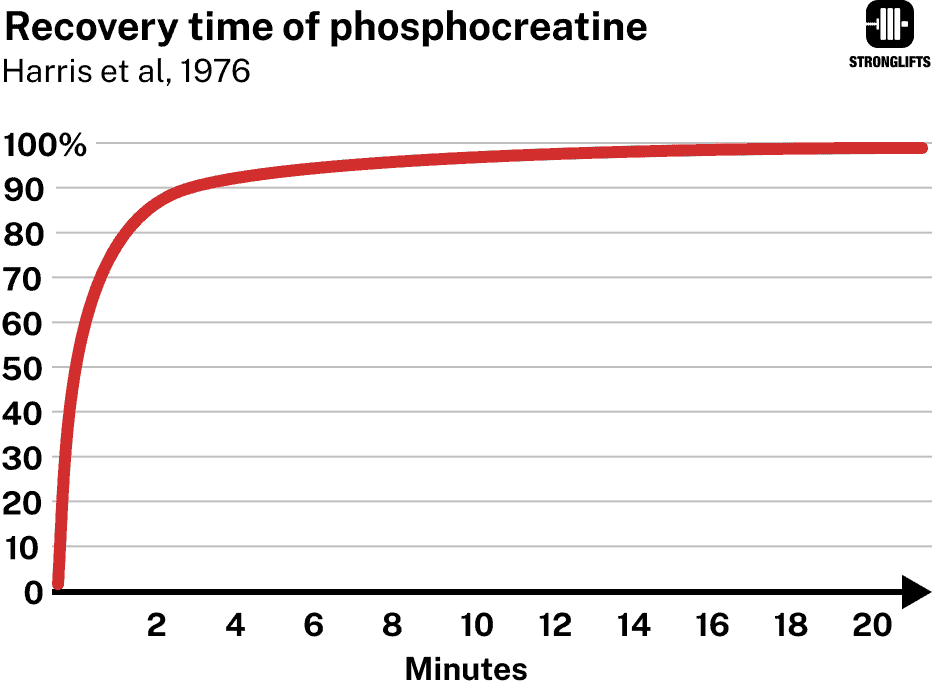
You don’t need full ATP-CP stores to complete lighter and easier sets. That’s why short rest periods of 1-2 min work fine during the first weeks of Stronglifts 5×5. However, once you’re doing heavier and harder sets, your muscles will rely more on your ATP-CP energy system to lift the weights. Rest periods of 3-5 min give them more time to recover. You’ll do more reps (10, 11).
This was shown in a study by Hernandez et al where they had people Bench Press four sets with 85% of their max (33). Longer rest times resulted in more reps done per set. This is obvious to anyone who has lifted for a while.
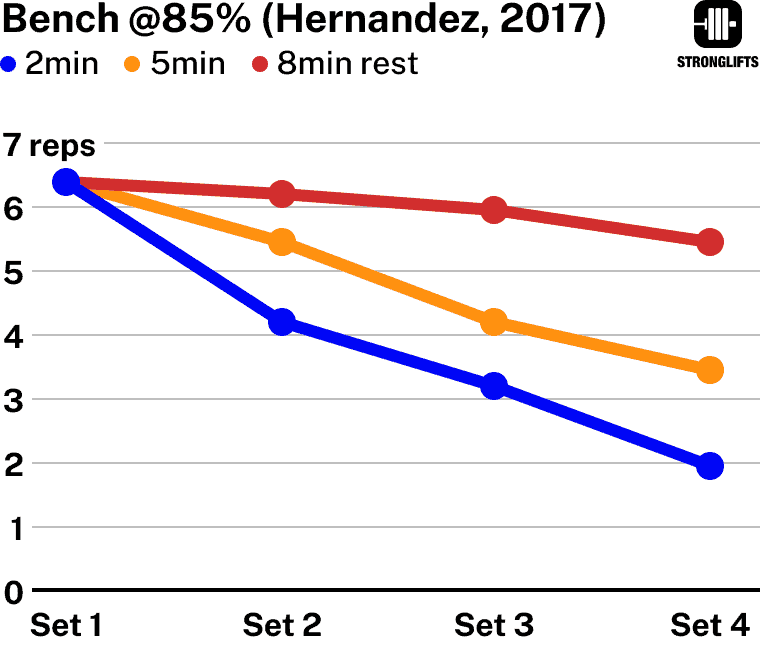
But don’t shorter rest times build more muscle? No. It’s the opposite. If you do less reps because you rest too little, your training volume will be lower and so you’ll build less muscle. 5×5 200lb with 3min rest is 5000lb volume. If you rest 1min, miss reps, and get say 5/4/3/3/2 200lb that’s only 3400lb or 32% less volume. Yet doing more volume results in more muscle gains (34).
This was shown in a study by Longo et al (35). The group resting 3min built bigger legs than the one resting only 1min. They had to do more sets to build the same amount of muscle as the 3min group. Shorter rest times therefore don’t save time. Longer rest times are actually more time-efficient because you don’t need to do as many sets to build the same amount of muscle.
Resting longer between sets will increase your workout duration. However there are two simple ways that you can save time:
- Only rest 5min before your hardest set. You don’t need to rest the full 5min for every set or exercise. If you can complete the set with only 3min rest, then only rest 3min.
- Switch to 5×5 top/back-off sets. This will reduce the amount of rest that you need between sets two to five. You’ll only need 5min rest for the first and heaviest set of an exercise.
The Stronglifts app has a dynamic rest timer that automatically starts after you log your set. If you fail, tap the set circle several times to decrease the reps. We’ll then suggest longer rest periods to help you complete your next set.
Repeat the weight
If you fail to do 5×5 with good form, then repeat the weight next workout.
Like this…
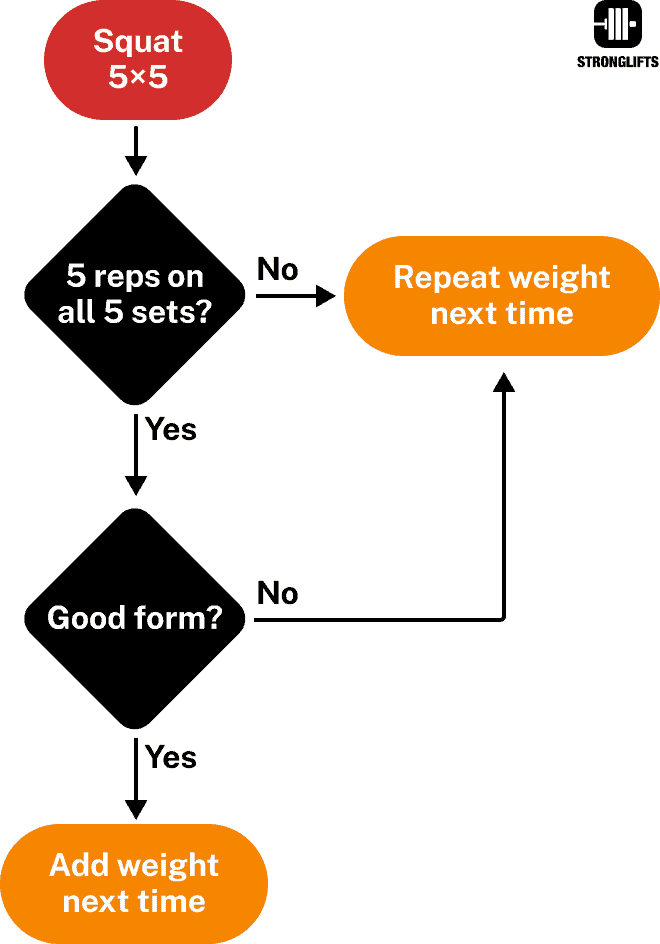
Say you have to Squat 205lb for 5×5. You can’t complete five reps on all sets. You do 5/5/5/3/2 – five reps on the first three sets, three reps on set four and two reps on set five. You did 20 total reps instead of 25.
Squat 205lb again next workout. Aim for 5×5.
Repeating the weight gives you the opportunity to address simple mistakes that may have caused fail reps. Examples…
- Didn’t get enough sleep last night? Go to bed early before your next workout to get proper recovery. You’re more likely to succeed.
- Didn’t eat enough today? Plan and prepare your meals in advance to make sure you get enough food for your next workout.
- Misgrooved the bar on the Bench Press? Avoid getting distracted in the gym. Don’t rush your sets so you can better focus on form.
No one has perfect workouts all the time. Small mistakes happen, and they’re often easy to fix. If you take a moment to think about why you might have failed, and what you could do better next time, then you’ll progress.
The Stronglifts app automatically repeats the weight next workout if you mark the set failed. Just tap the set circle several times to log less than five reps. You can also tap/hold on the set and then select change reps.
Microload
Microloading means using increments smaller than 5lb. You microload by using fractional plates that weigh 1.25lb or less. This helps you make smaller and more manageable jumps in weight. Your progression becomes more gradual and sustainable. You fail reps less as a result.
Failing reps usually means that you’re past the easy beginner gains. Adding weight now requires more effort. It’s normal for your progress to slow down over time. Strength gains follow the law of diminishing returns (7, 8). The stronger you get, the harder it is to get even stronger. Your Squat will increase from 0 to 200lb much faster than from 200lb to 400lb.
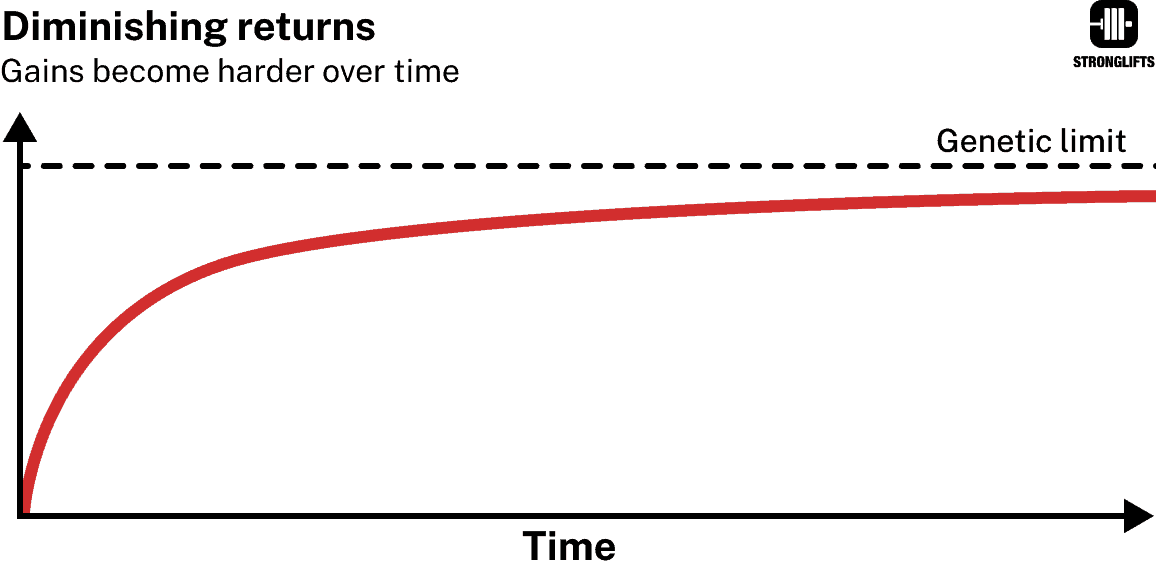
If your body needs more time to get stronger, then it’s only logical to use a slower progression. Use increments it can handle. Your body will get stronger at the rate that it can get stronger. You can’t force it to grow stronger faster by throwing bigger increments at it. Just like you can’t force a tree to grow faster.
The old-time lifters used shot-loaded barbells that they filled up with lead. This made small, incremental progress possible each workout. We’re going to use fractional plates to microload. These plates are smaller and lighter than the typical plates you’ll find in gyms.
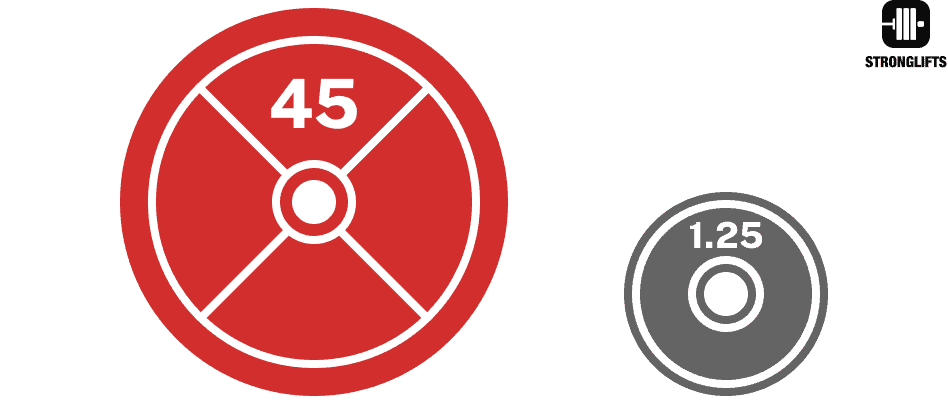
| Plate type | Weight lb | Weight kg |
|---|---|---|
| Normal | 45 | 20 |
| Normal | 25 | 10 |
| Normal | 10 | 5 |
| Normal | 5 | 2.5 |
| Normal | 2.5 | 1.25 |
| Fractional | 1.0 | 0.5 |
| Fractional | 0.5 | 0.25 |
| Fractional | 0.25 | 0.125 |
A study by Hostler et al compared 8 weeks of 5lb and 0.5-1lb increments on the Bench Press (36). The men who used smaller increments of 0.5-1lb to microload increased their Bench Press more.
| Hostler et al, 2001 | 5lb increment | 0.5-1lb increment |
|---|---|---|
| Bench 1RM before | 194lb | 185lb |
| Bench 1RM after | 222.9lb | 224.9lb |
| Gain in lb | 27.8lb | 39.9lb |
| Gain in % | 14.3% | 21.6% |
Microloading is most helpful on exercises that work smaller muscles. The Bench and Overhead Press work your chest, shoulders and triceps. Squats and Deadlifts work bigger muscles like your legs and back. That’s why you can Squat heavier weights than you can Bench Press.
Adding 5lb on the Overhead Press is harder than on the Deadlift. The weight you lift on the Overhead Press is lighter because it uses smaller muscles. And so the same 5lb is a relatively greater and harder increase. Compare…
| Weight | Increments | Relative increase |
|---|---|---|
| 200 | 10lb | 5% |
| 200 | 5lb | 2.5% |
| 100 | 5lb | 5% |
| 100 | 2.5lb | 2.5% |
Adding 5lb to a 100lb Overhead Press is an increase of 5%. That’s like adding 10lb to a 200lb Deadlift. But adding 2.5lb to that same 100lb Overhead Press is an increase of only 2.5%. That’s like adding 5lb to a 200lb Deadlift.
This shows you how the exact same increment can be harder on some lifts. Microloading helps you use increments that your body can handle. Progress becomes more sustainable and so you fail less reps. This builds momentum: the weight on the bar slowly but surely increases. You can see that you’re getting stronger which motivates you to keep pushing forward.
Microload once you’ve failed reps. Switch to increments of 2.5lb (1.25/side) or less. You should definitely do this on exercises that work smaller muscles like the Bench Press and Overhead Press. You can also do this on the Squat and Deadlift if you like. Even competitive powerlifters use increases as small as 1lb when attempting to break records (1).
Fractional plates are small and weigh little. Buy a pair and put them in your gym bag. You can find fractional plates here:
- Rogue 1lb and 0.25lb plates
- Rogue 0.5kg and 0.125kg plates
- Strength Shop – 0.5kg, 0.25kg and 0.125kg (with bag)
The Stronglifts app supports microloading. Start workout – tap the weight – tap increments. Then add the small plates in the plate area below.
Wear a lifting belt
Lifting belts help you do more reps and lift more weight. They increase intra-abdominal pressure, improve power transfer, and add lower back support. The belt gives your abs a surface to push against. They contract harder which increases the pressure in your abdomen and torso.
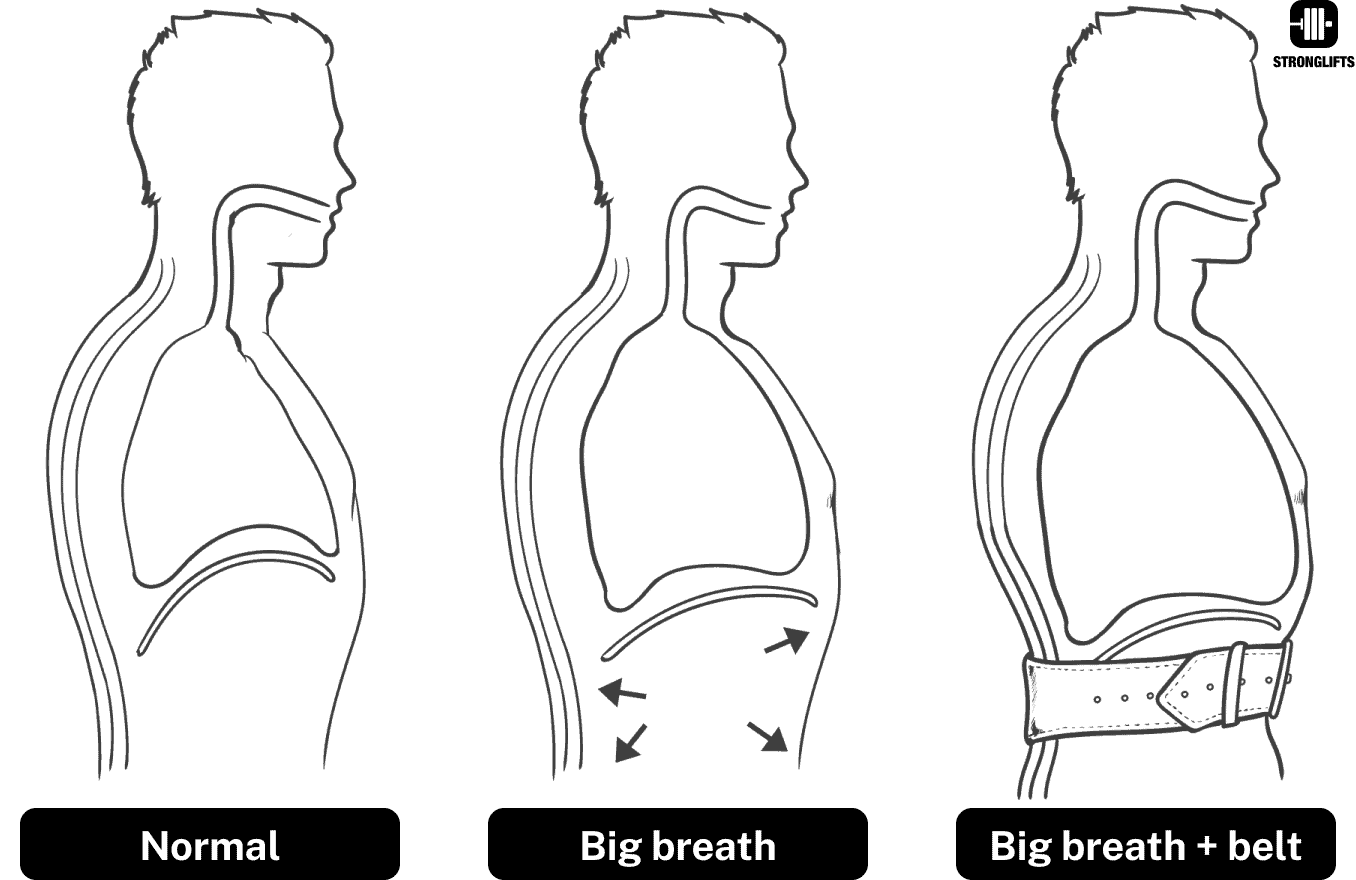
Think of your body like a chain. Your legs are the first link, the bar the last one. When you Squat you’re trying to transfer power through this chain. If it’s loose in the middle, it will wiggle around and you lose power. The belt stiffens your trunk. The power your legs create can better transfer through your torso into the bar. You can do more reps and lift more weight.
Lifting belts don’t make your abs weak. They cue them to contract harder (37, 38). With practice you’ll be able to lift ~10% more weight with the belt. This exposes your abs to more weight and so they’ll work harder and get stronger. Say your best Squat is 200lb. You start using a belt and get to 300lb after a few months. Your legs, back and abs gain strength and muscle in the process. You don’t lose all those gains when you remove the belt. The gains carry over and so Squatting the same 200lb without belt will be easier than before.
Wearing a lifting belt isn’t cheating. It doesn’t substitute your strength or skill. It’s not a performance-enhancing drug. It’s not a device that artificially lifts the weights for you. You still have to use your own strength and effort. The belt simply stiffens your trunk so you get more reps and lift more weight. It helps you train harder than you would do without belt.
Lifting belts add lower back support by increasing intra-abdominal pressure. This is important to keep your back safe when lifting heavy weights. The added sense of security can give you the psychological boost you need to push yourself harder, complete harder reps, and progress better. The large majority of powerlifters wear a belt for their heavy lifts.
Get a lifting belt that’s 4″ wide all around and 10mm thick. Avoid belts that are 4-6″ wide in the back but only 2″ in the front. Your abs will have less surface to push against and so you’ll get less support. Lifting belts that are only 4-8mm thick also provide less support. Avoid them too.

Quality belts will last years. I’ve used an Inzer Forever Belt for almost 15 years (here to Deadlift 509lb). I’ve used it every week, for more than 1000 workouts. It still works great. One of my brothers has used the Rogue Ohio Lifting belt for a good 10 years. It’s great too. If you balk at the price – many people spend way more money each year on bogus supplements that don’t even work. Belts are proven to help you get more reps, lift more weight, and progress better while protecting your back. Just get one.
Wear the lifting belt for Squats, Deadlifts, Overhead Press and Barbell Rows. I wear it for Bench Press too but not everyone likes that. It’s normal if the belt feels weird at first. Lifting with a belt is a skill. Stick with it and you’ll eventually feel naked training without it. Don’t wear the belt for your lighter warmup sets. Use it for your heavier sets only.
Use the mixed grip on Deadlifts
Failed reps on Deadlifts often happen due to grip issues. Your legs and back can do more reps. But your hands can’t hold the bar. You can fix this instantly by using the mixed grip for your heavy sets. Grip the bar like a baseball bat – one palm facing you, one palm facing away.
When you start Stronglifts 5×5, you Deadlift with both palms facing you. This is the double overhand grip. You also use it for Barbell Rows.
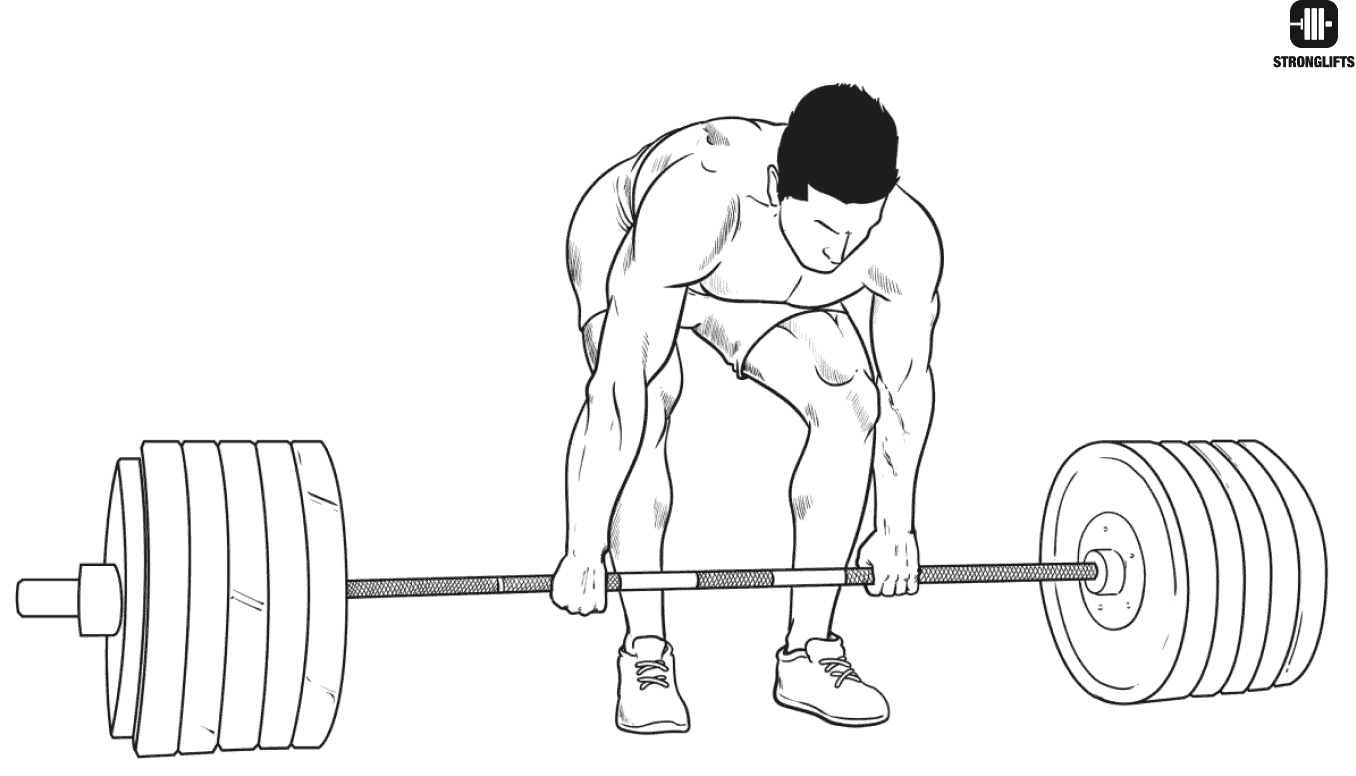
Your Deadlift will progress for weeks using the double overhand grip. Then one day your grip will get tired and give out during your set. A few workouts later you’ll find yourself unable to lift the bar off the floor for even one rep. It will feel too heavy to hold for your hands.
Before your grip was stronger than your legs and back muscles. You used your hands every day for various tasks. Now your legs and back are stronger. They can lift more weight than your hands can hold.
Don’t give up yet. Try the mixed grip. Grab the bar with one palm facing towards you, and the other palm facing away from you. Like this…
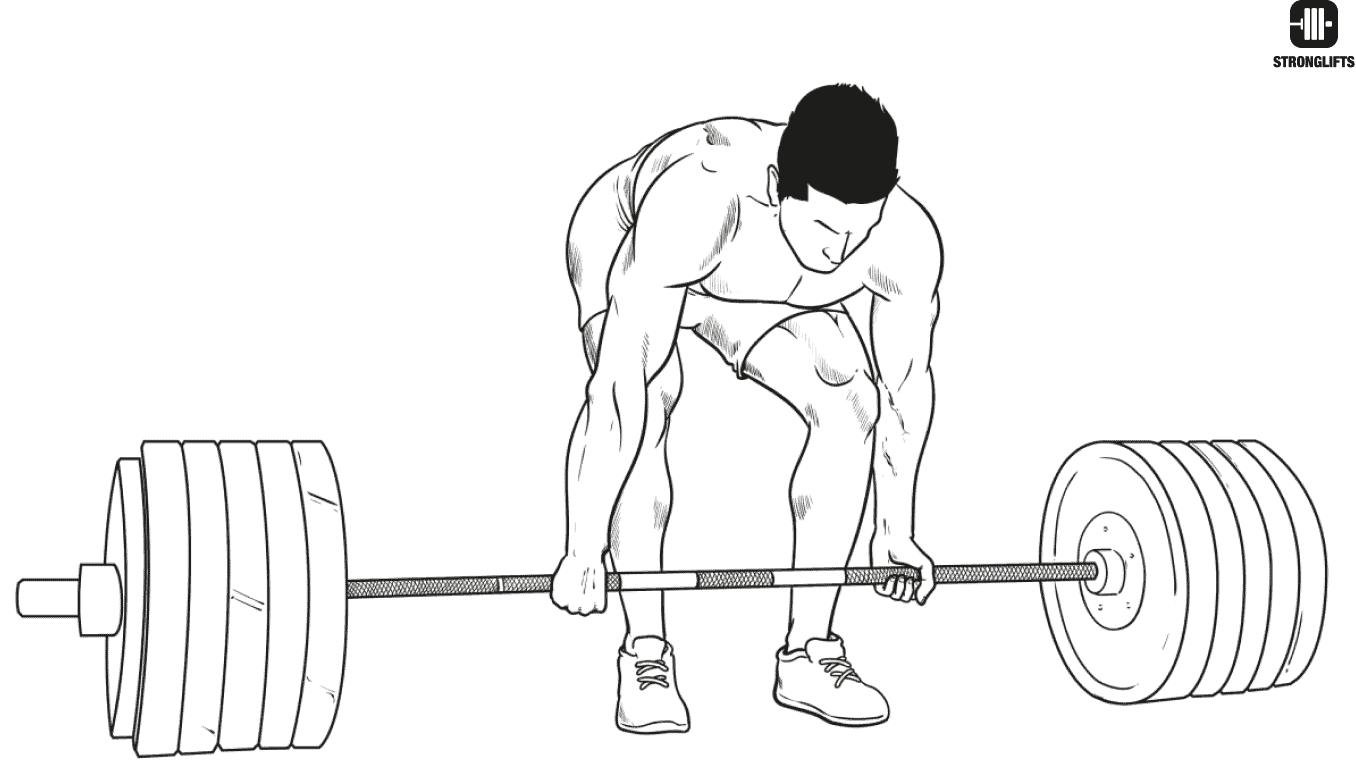
This means that you grip the bar like a baseball bat.
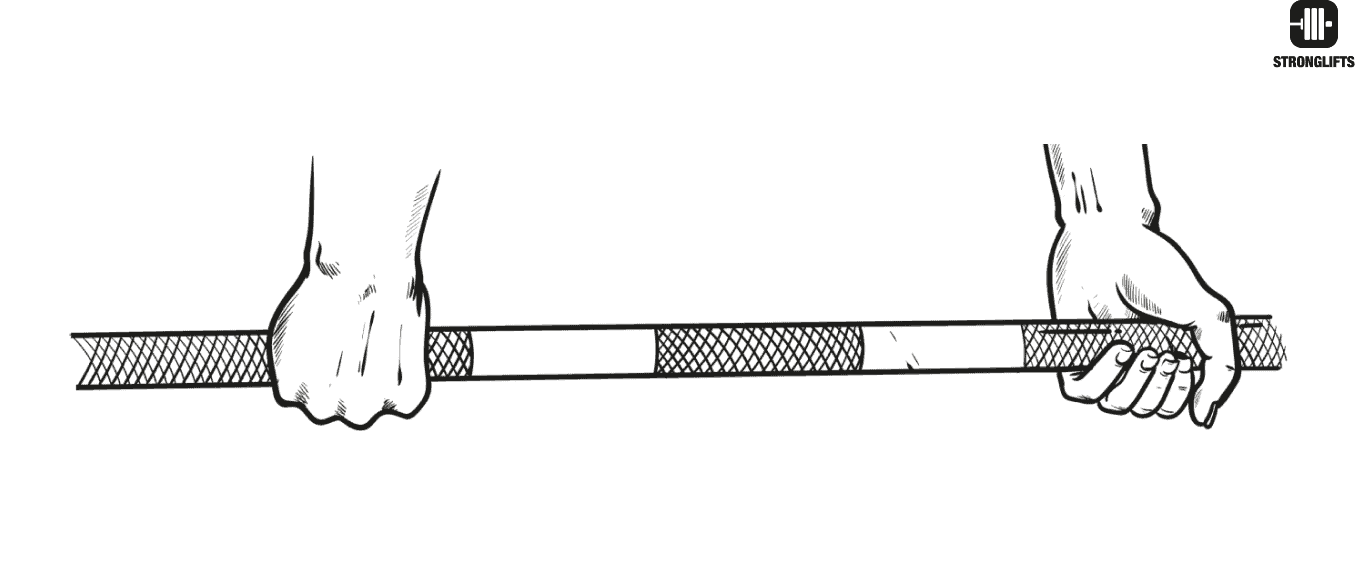
If you try the mixed grip, you’ll find that you can Deadlift the weight that you just struggled to pull with the double overhand grip. Here’s why…
- When you grip a heavy weight with both palms facing you, the bar will roll down towards your fingers. This causes your hands to open up and so you lose the bar. It doesn’t matter how hard you hold the bar or how much you strengthen your grip. The bar rotation is inevitable with the double overhand grip.
- When you use the mixed grip the only way the bar can roll down towards your fingers in your one hand is if it rolls up towards your wrist in your other hand. The bar can’t roll up against gravity. The weight is too heavy for that. And so the mixed grip cancels the bar rotation. That’s why the weight becomes easier to hold.
A study by Pratt et al compared the double overhand grip, mixed grip and hook grip. The mixed grip was the easiest and most used grip (39). It’s not cheating (1). It’s safe to use. Most powerlifters use the mixed grip (40). Yet the risk of injury is low and on par with dancing (41, 42, 43, 44).
If you choose to Deadlift with the double overhand grip only to prioritize your forearms, you’ll pull ~20% less weight than with the mixed grip. And so you’ll undertrain your legs and back. These muscles are bigger and stronger than your forearms. They have a greater impact on your overall physique.
Use the mixed grip for your heavier Deadlift sets only. Continue to use the double overhand grip for your lighter and easier sets. Don’t wait for your grip to fail mid-set to use the mixed grip. Use it before you start your set so you don’t fail in the first place. Here’s an example…
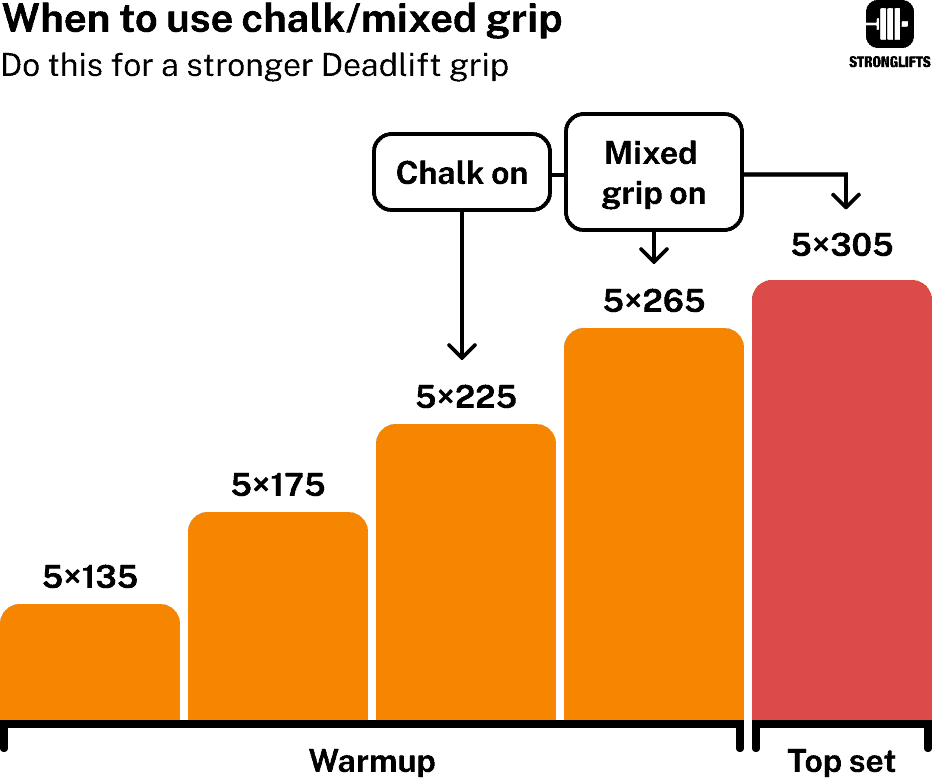
If you don’t want to use the mixed grip for Deadlifts then use straps for your heaviest sets only. Straps improve grip strength by canceling the bar rotation like the mixed grip does (45). Note that straps and gloves are not allowed in powerlifting competitions (1). You’re expected to Deadlift the bar using your bare hands, only using chalk for a better grip.
Frequently Asked Questions
What if you fail on Bench Press but not on Squat?
Repeat the weight on the Bench Press only.
Don’t repeat the weight on Squats if you completed five reps on all five sets with good form. You didn’t fail reps so just add weight next workout. Same for Barbell Rows: if you did 5×5, then add weight next workout regardless of what you did on the Bench Press.
If you’re confused, use the Stronglifts app. It repeats the weight on exercises you failed on while adding weight on the ones you succeed.
Shouldn’t you keep the weight of each exercise in line with others?
No. The weight you lift will not be the same across all exercises.
You can lift more weight on exercises that use bigger muscles The Bench and Overhead Press work smaller muscles like your chest, shoulders and triceps. And so it’s normal to lift less on these lifts than on Squats and Deadlifts.
It’s not uncommon for men to Deadlift 300lb within a few months of training. However few men will reach the same weight on the Overhead Press. Unless you have some serious technical errors, mental blocks or past injuries holding you back, you should expect to progress like this…
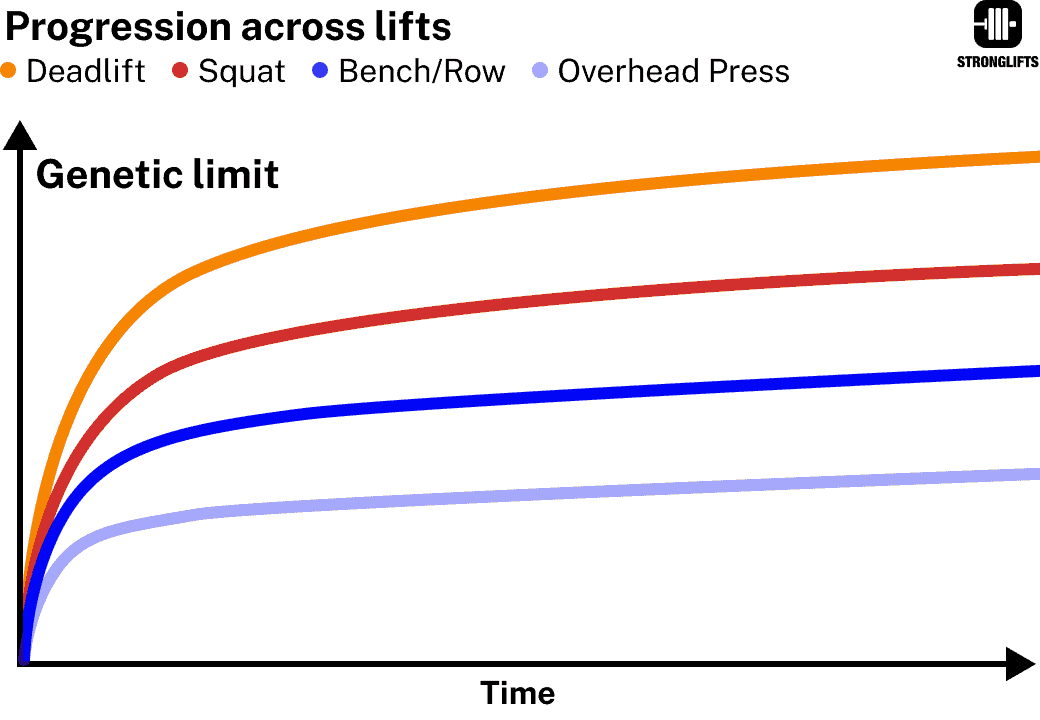
Your Squat and Deadlift will progress faster than your Bench and Overhead Press. If you hold back on your SQ/DL to keep the weight inline with your BP/OHP, you will undertrain your bigger legs and back muscles.
I recommend using the Stronglifts app so you don’t make this mistake. It will only repeat the weight on exercises you failed on.
What if you repeat the weight but still fail next workout?
Try one more workout with the same weight.
Like this…
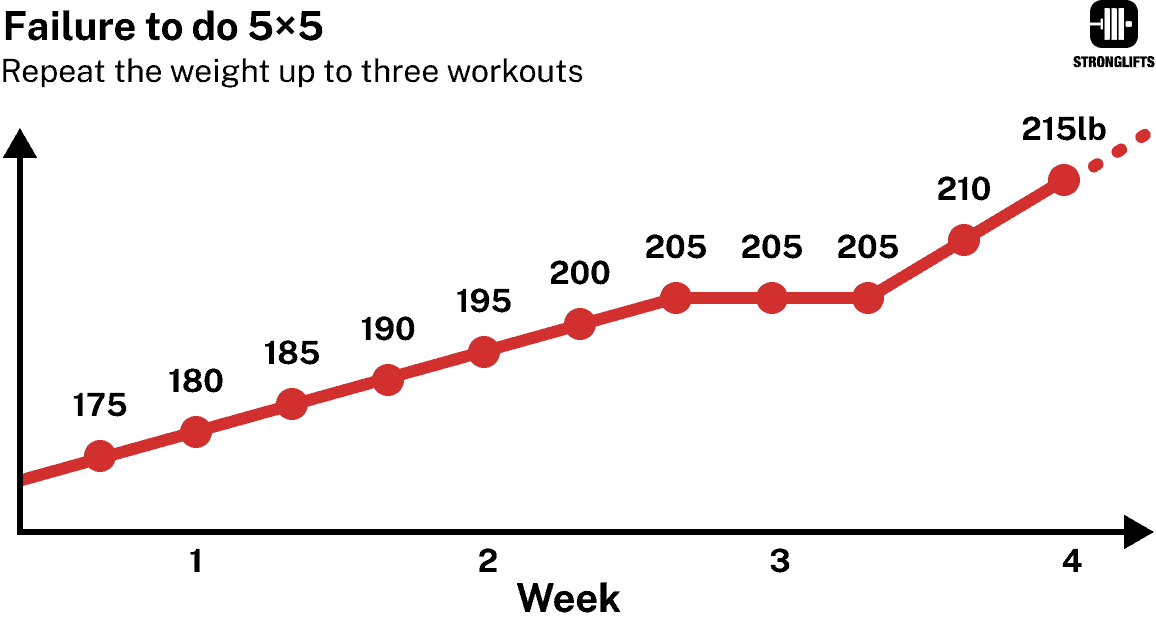
You repeat 205lb for three workouts. The first two times you fail to Squat 205lb for 5×5. This motivates you to go to bed on time. You also try rest periods of 3-5 min. As a result, you complete 205lb for 5×5 on your third attempt. You decide to microload after this for more gradual and sustainable progress. You switch to 2.5lb increments and plan 207.5lb next.
When you repeat the weight your goal should be to do 5×5. If you don’t succeed, but you’re able to do more total reps than last time, it’s important to celebrate that. More reps with the same weight counts as progress too.
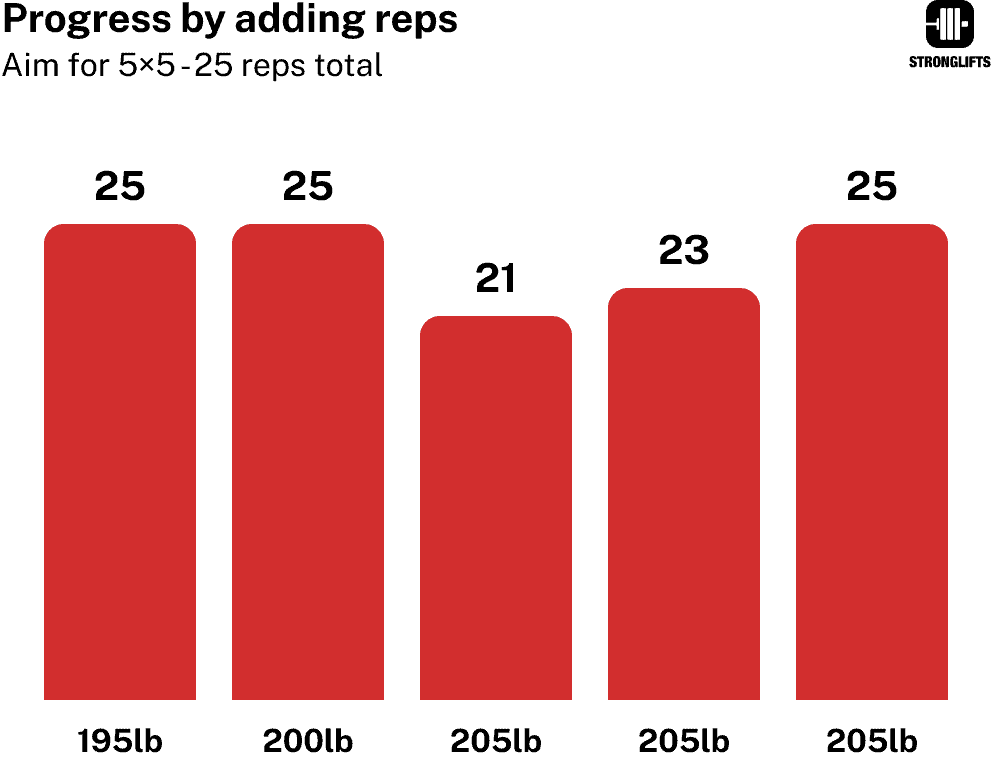
Here you lift 200lb for 5×5 – 25 reps total. Next workout you do 5/5/5/3/3 – 5 reps in the first three sets but only 3 reps in the last two. You try 205lb again, and do 5/5/5/4/4. No 5×5 yet but two reps more. Good, that’s progress. The next workout you achieve 205lb for 5×5.
What if you repeat the weight three times but still fail?
Stop trying and deload. Reduce the weight by about 10% and work your way back up. The Stronglifts app does that automatically for you.
Why not deload after one failed workout already?
Maybe you can complete 5×5 next workout. You may not need to deload.
Say today is Bench Press 175lb for 5×5. You’re in a rush and not that focused. On set four you set up too high on the bench. The bar hit the uprights mid-set. This throws you off balance and so you fail to do more than three reps.
Don’t you think you could Bench Press 175lb for 5×5 next workout if you have better focus? If so, then why deload?
In contrast, say you Bench 175lb for 5×5. Next workout you do 180lb but only manage 3/2/1/0/0. It’s a disaster. 180lb seems like too much and so you want to deload. Makes more sense. However – why couldn’t you bench 180lb for even one set of five when you did 175lb for 5×5 last time? Something looks off. Repeating the weight gives you the opportunity to fix that.
Wouldn’t it be better to microload before failing reps?
Yes.
Smaller weight jumps create a more gradual progression and less failure. This can improve your motivation and confidence.
The problem is that gyms often don’t have small plates to microload. Many people also resist the idea of investing in fractional plates. They can progress fine with 5lb or even 10lb increments so they don’t see any reason to get small plates (“don’t fix it until it’s broke”). It’s only when they start failing reps that they realize the benefits of microloading.
If you want to microload from day one, do it. Progress may seem slower at first. But everyone’s progress slows down over time (7, 8). Someone who starts with bigger increments will progress faster initially but likely end at the same place in a year. The only difference is that they’ll have failed more while you had smoother progress.
What if your gym doesn’t have small plates for microloading?
Buy a pair and put them in your gym bag. They’re light and don’t take much space. You can find fractional plates here:
- Rogue 1lb and 0.25lb plates
- Rogue 0.5kg and 0.125kg plates
- Strength Shop – 0.5kg, 0.25kg and 0.125kg (with bag)
Fractional plates have a high cost per lb compared to big plates. They have a tighter weight tolerance which costs more to manufacture. You’re paying extra for the more precise weight accuracy of fractional plates.
Alternatives to fractional plates are washers or ankle weights. You can also get two small chains at the DIY shop and loop that around the bar.
What if you’ve tried everything and are still stuck?
Read what to do when you plateau on Stronglifts 5×5.
Join the Stronglifts community to get free access to all the spreadsheets for every Stronglifts program. You’ll also get 15% off Stronglifts Pro, and daily email tips. Enter your email below to sign up today for free.
References
1. “Technical Rules.” International Powerlifting Federation IPF – International Powerlifting Federation IPF.
2. Kubo, Keitaro et al. “Effects of squat training with different depths on lower limb muscle volumes.” European journal of applied physiology vol. 119,9 (2019): 1933-1942.
3. McLaughlin, Thomas M., and Nels H. Madsen. “Bench Press: Bench press techniques of elite heavyweight powerlifters.” Strength & Conditioning Journal 6.4 (1984): 44-44.
4. McLaughlin Thomas M. Bench Press More Now : Breakthroughs in Biomechanics and Training Methods. 1984.
5. Sheridan, Andrew et al. “Presence of Spotters Improves Bench Press Performance: A Deception Study.” Journal of strength and conditioning research vol. 33,7 (2019): 1755-1761.
6. Armes, Cedrik et al. “Just One More Rep!” – Ability to Predict Proximity to Task Failure in Resistance Trained Persons.” Frontiers in psychology vol. 11 565416. 23 Dec. 2020.
7. Latella, Christopher et al. “Long-Term Strength Adaptation: A 15-Year Analysis of Powerlifting Athletes.” Journal of strength and conditioning research vol. 34,9 (2020): 2412-2418.
8. Appleby, Brendyn et al. “Changes in strength over a 2-year period in professional rugby union players.” Journal of strength and conditioning research vol. 26,9 (2012): 2538-46.
9. Harris, R C et al. “The time course of phosphorylcreatine resynthesis during recovery of the quadriceps muscle in man.” Pflugers Archiv : European journal of physiology vol. 367,2 (1976): 137-42.
10. Ratamess, Nicholas A., et al. “The effect of rest interval length on metabolic responses to the bench press exercise.” European Journal of Applied Physiology, vol. 100, no. 1, 2007, pp. 1-17.
11. Willardson, Jeffrey M, and Lee N Burkett. “A comparison of 3 different rest intervals on the exercise volume completed during a workout.” Journal of strength and conditioning research vol. 19,1 (2005): 23-6.
11. Halson, Shona L. “Nutrition, Sleep and Recovery.” European Journal of Sport Science, vol. 8, no. 2, 2008, pp. 119-126.
12. Smith, Isaac et al. “Sleep restriction and testosterone concentrations in young healthy males: randomized controlled studies of acute and chronic short sleep.” Sleep health vol. 5,6 (2019): 580-586.
13. Kirschen, Gregory W et al. “The Impact of Sleep Duration on Performance Among Competitive Athletes: A Systematic Literature Review.” Clinical journal of sport medicine : official journal of the Canadian Academy of Sport Medicine vol. 30,5 (2020): 503-512.
14. Chaput, Jean-Philippe et al. “Sleeping hours: what is the ideal number and how does age impact this?.” Nature and science of sleep vol. 10 421-430. 27 Nov. 2018.
15. Kerr, Zachary Y et al. “Epidemiology of weight training-related injuries presenting to United States emergency departments, 1990 to 2007.” The American journal of sports medicine vol. 38,4 (2010): 765-71.
16. Gantois, Petrus et al. “Mental Fatigue From Smartphone Use Reduces Volume-Load in Resistance Training: A Randomized, Single-Blinded Cross-Over Study.” Perceptual and motor skills vol. 128,4 (2021): 1640-1659.
17. Ding, Liyi et al. “Effectiveness of Warm-Up Intervention Programs to Prevent Sports Injuries among Children and Adolescents: A Systematic Review and Meta-Analysis.” International journal of environmental research and public health vol. 19,10 6336. 23 May. 2022.
18. Taber, Christopher B et al. “Exercise-Induced Myofibrillar Hypertrophy is a Contributory Cause of Gains in Muscle Strength.” Sports medicine (Auckland, N.Z.) vol. 49,7 (2019): 993-997.
19. Keogh, Justin W L et al. “Can absolute and proportional anthropometric characteristics distinguish stronger and weaker powerlifters?.” Journal of strength and conditioning research vol. 23,8 (2009): 2256-65.
20. Brechue, William F, and Takashi Abe. “The role of FFM accumulation and skeletal muscle architecture in powerlifting performance.” European journal of applied physiology vol. 86,4 (2002): 327-36.
21. Reya, Matija et al. “Factors Underlying Bench Press Performance in Elite Competitive Powerlifters.” Journal of strength and conditioning research vol. 35,8 (2021): 2179-2186.
22. Slater, Gary John et al. “Is an Energy Surplus Required to Maximize Skeletal Muscle Hypertrophy Associated With Resistance Training.” Frontiers in nutrition vol. 6 131. 20 Aug. 2019.
23. Robinson, Scott Lloyd et al. “A nutrition and conditioning intervention for natural bodybuilding contest preparation: case study.” Journal of the International Society of Sports Nutrition vol. 12 20. 1 May. 2015.
24. Rossow, Lindy M et al. “Natural bodybuilding competition preparation and recovery: a 12-month case study.” International journal of sports physiology and performance vol. 8,5 (2013): 582-92.
25. Helms, Eric R et al. “Evidence-based recommendations for natural bodybuilding contest preparation: nutrition and supplementation.” Journal of the International Society of Sports Nutrition vol. 11 20. 12 May. 2014.
26. Paddon-Jones, Douglas et al. “Protein, weight management, and satiety.” The American journal of clinical nutrition vol. 87,5 (2008): 1558S-1561S.
27. Wycherley, Thomas P et al. “A high-protein diet with resistance exercise training improves weight loss and body composition in overweight and obese patients with type 2 diabetes.” Diabetes care vol. 33,5 (2010): 969-76.
28. Jäger, Ralf et al. “International Society of Sports Nutrition Position Stand: protein and exercise.” Journal of the International Society of Sports Nutrition vol. 14 20. 20 Jun. 2017,
29. Swinton, Paul A et al. “A biomechanical analysis of straight and hexagonal barbell deadlifts using submaximal loads.” Journal of strength and conditioning research vol. 25,7 (2011): 2000-9.
30. Pratt, Jedd et al. “Forearm electromyographic activity during the deadlift exercise is affected by grip type and sex.” Journal of electromyography and kinesiology : official journal of the International Society of Electrophysiological Kinesiology vol. 53 (2020): 102428.
31. Schoenfeld, Brad J et al. “Effect of repetition duration during resistance training on muscle hypertrophy: a systematic review and meta-analysis.” Sports medicine (Auckland, N.Z.) vol. 45,4 (2015): 577-85.
32. Headley, Samuel A et al. “Effects of lifting tempo on one repetition maximum and hormonal responses to a bench press protocol.” Journal of strength and conditioning research vol. 25,2 (2011): 406-13.
33. Hernandez, Dennis J et al. “Effect of Rest Interval Duration on the Volume Completed During a High-Intensity Bench Press Exercise.” Journal of strength and conditioning research vol. 35,11 (2021): 2981-2987.
34. Schoenfeld, Brad Jon and Jozo Grgic. “Evidence-Based Guidelines for Resistance Training Volume to Maximize Muscle Hypertrophy.” Strength & Conditioning Journal (2017): n. pag.
35. Longo, Ariel Roberth et al. “Volume Load Rather Than Resting Interval Influences Muscle Hypertrophy During High-Intensity Resistance Training.” Journal of strength and conditioning research vol. 36,6 (2022): 1554-1559.
36. Hostler, D et al. “The effectiveness of 0.5-lb increments in progressive resistance exercise.” Journal of strength and conditioning research vol. 15,1 (2001): 86-91.
37. Miyamoto, K et al. “Effects of abdominal belts on intra-abdominal pressure, intra-muscular pressure in the erector spinae muscles and myoelectrical activities of trunk muscles.” Clinical biomechanics (Bristol, Avon) vol. 14,2 (1999): 79-87.
38. Escamilla, Rafael F et al. “An electromyographic analysis of sumo and conventional style deadlifts.” Medicine and science in sports and exercise vol. 34,4 (2002): 682-8.
39. Pratt, Jedd et al. “Forearm electromyographic activity during the deadlift exercise is affected by grip type and sex.” Journal of electromyography and kinesiology : official journal of the International Society of Electrophysiological Kinesiology vol. 53 (2020): 102428.
40. Analysis by Stronglifts of the IPF 2023 World classic championships. 198 male elite athletes from all weight categories competed in the open class group A. 69.2% Deadlifted using the mixed grip. 29.8% used the hook grip. One athlete used a mixed hook grip.
41. Keogh, Justin W L, and Paul W Winwood. “The Epidemiology of Injuries Across the Weight-Training Sports.” Sports medicine (Auckland, N.Z.) vol. 47,3 (2017): 479-501.
42. Siewe, J et al. “Injuries and overuse syndromes in powerlifting.” International journal of sports medicine vol. 32,9 (2011): 703-11.
43. Raske, Ase, and Rolf Norlin. “Injury incidence and prevalence among elite weight and power lifters.” The American journal of sports medicine vol. 30,2 (2002): 248-56.
44. Bengtsson, Victor et al. “Narrative review of injuries in powerlifting with special reference to their association to the squat, bench press and deadlift.” BMJ open sport & exercise medicine vol. 4,1 e000382. 17 Jul. 2018
45. Coswig, Victor S et al. “Kinematics and Kinetics of Multiple Sets Using Lifting Straps During Deadlift Training.” Journal of strength and conditioning research vol. 29,12 (2015): 3399-404.
46. Lima, Bruce M et al. “Planned Load Reduction Versus Fixed Load: A Strategy to Reduce the Perception of Effort With Similar Improvements in Hypertrophy and Strength.” International journal of sports physiology and performance vol. 13,9 (2018): 1164-1168.




